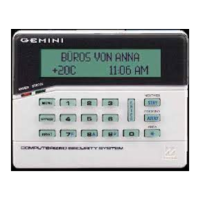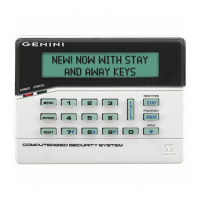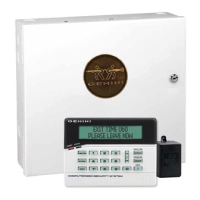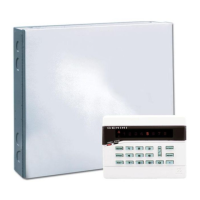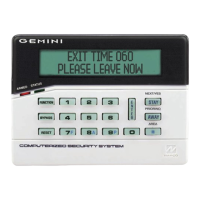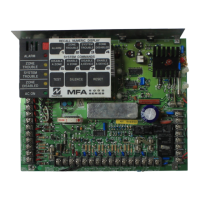NAPCO Security Systems
GEM-P1632 Programming Instructions
WI897B 8/98
Page 61
GLOSSARY
Test Timer; Cancel Next Test Timer Report on Any Report
The test timer schedule is programmed using Napco's PCD3000 Quickloader Software. If “Test Timer” (Address 0460-0469) is
programmed, an automatic test report will be transmitted to the central station on the scheduled day(s) at the scheduled time. (UL
installations require a report at least every 24 hours.) To report test timer, select Report Test Timer and program a report code.
Program the Test Timer event schedule and reporting time. If “Cancel Next Test Timer Report on Any Report” (Address 0394) is
programmed, any report will cause the next test-timer transmission to be aborted, however subsequent test-timer transmissions will
report as scheduled. Do not program this feature in UL installations.
Timeout
Specifies the length of time that an alarm, alert, or delay will remain active. See Time Selection.
Time Selection
The following times are programmable:
NOT ES:
(1) The output used for Burglary must be at least 4 minutes in Residential UL installations, 15 minutes in Commercial UL installations.
(2) If both locations are left blank, this feature will remain active until the system is disarmed. When both locations are programmed
“F”, maximum time will be 4 hours, 15 minutes (255 minutes). (3) If both locations are left blank, this feature will not activate (timeout
= 0). (4) In UL installations: Maximum Exit Delay = 60 sec; Maximum Entry Delay = 45 sec. (5) If programming locations are left blank,
delay will default to 10 sec. (6) Time in units of disarmed hours (accumulated between armed periods).
Any timeout up to those shown in the foregoing table may be programmed. Note that each of the above times is programmed in two
locations. The first location has an assigned time factor of 16, the second a time factor of 1.
Note:
If both programming
locations are left blank, refer to the notes in the Time Selection table for feature timeout.
To select a time up to 15 seconds, 15 minutes, 15 hours, or 15 days, program the respective entry into the second box only; do not
program the first box. To select a time greater than 15 seconds, 15 minutes, 15 hours or 15 days, program both boxes as follows:
1. For the feature selected, choose an appropriate time in units shown (all seconds, minutes, hours, or days — not minutes and
seconds, etc.).
2. Divide the time chosen by 16. Enter the quotient in the 1st BOX and the remainder in the 2nd BOX.
3. Check entries by adding the contents of the 2nd BOX to 16 times the contents of the 1st BOX. (Remember that a “zero” entry
represents 10.)
Example. Program Entry Delay 1 for 1 minutes.
1. Entry Delay 1 is in units of seconds, thus delay time is 90 seconds.
2. Divide by 16: 90/16 = 5 (quotient) + 10 (remainder). Enter the quotient in the 1st BOX and the remainder in the 2nd BOX:
TIME(1) UNITS MAX. PROG. TIME ADDRESS
PGM2 OUTPUT TIMEOUT MIN. UNTIMED(2) 0710
PGM2 OUTPUT ACCESS CONTROL TIME SEC. 4 MIN, 15 SEC (255 SEC) 0711
BURGLARY OUTPUT MIN. UNTIMED(1)(2) 0712
PULSE-BURG OUTPUT MIN. UNTIMED(1)(2) 0713
PGM1 OUTPUT MIN. UNTIMED(2) 0714
ABORT DELAY SEC. 4 MIN, 15 SEC (255 SEC)(3) 0715
CHIME TIME SEC. 63.25 SEC (255 QTR-SEC)(3) 0716
AC-FAIL REPORT DELAY 10 MIN. 42 HR, 30 MIN (2550 MIN) 0717
EXIT DELAY SEC. 4 MIN, 15 SEC (255 SEC)(4) 0000
ENTRY DELAY 1 SEC. 4 MIN, 15 SEC (255 SEC)(4) 0001
ENTRY DELAY 2 SEC. 4 MIN, 15 SEC (255 SEC)(4) 0002
1st BOX 2nd BOX
tx16 tx1
Time t: 0 1 2 3 4 5 6 7 8 9 10 11 12 13 14 15
Entryblank (•)1234567890BCDEF
1st BOX 2nd BOX
50
quotient remainder (“0” for 10)
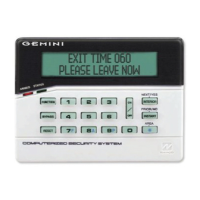
